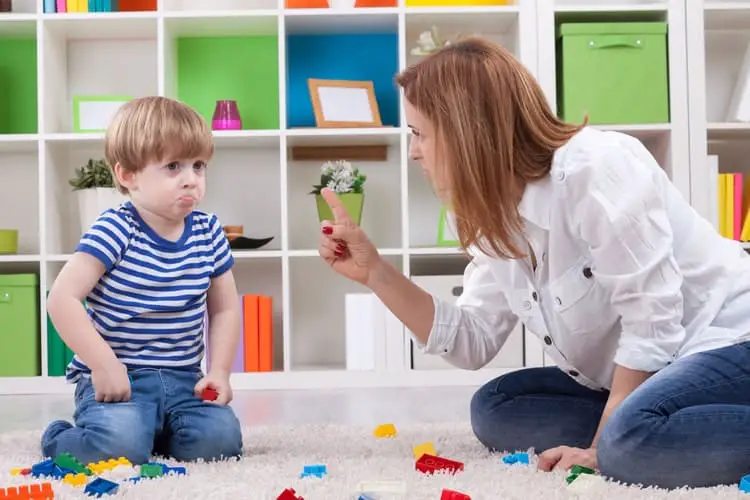Understanding “Bad Behavior”
Most of the time, what we consider bad behavior in toddlers is the result of poor impulse control. Most children don’t begin to develop impulse control until they are between the ages of 3.5 and 4 years old.
For the most part, toddlers aren’t trying to be bad, they just can’t help themselves. If you have ever seen a toddler touch something immediately after they were told not to, you’ve witnessed a lack of impulse control in action.
While it can be frustrating, acting out and misbehaving is a typical part of toddler development. They can do so at anytime and for any reason (like a missed nap or a scratchy t-shirt). But trying to understand why a toddler is acting out will help you figure out the best way to get them to stop.
How To Correct Bad Behavior
The best way to help a child learn the difference between appropriate and inappropriate behaviors is consistency. A 3-year-old is too young to understand why running through the house is okay sometimes (when you are playfully chasing them around) and not okay other times (when it’s time to brush their teeth).
Creating consistent rules, clear boundaries, and proportionate consequences can help a toddler understand what you expect of them. Of course, they won’t always be able to stay the course.
In those cases, you’ll need to rely on these 7 age-appropriate discipline tips for the 3-year-old in your life.
1. Know the warning signs
Temper tantrums are a normal part of childhood development. Toddlers can be set off by anything from a frustrating game to a playmate who won’t share toys. Fortunately, some outbursts can be stopped before they start if you know the child’s weaknesses. For example, if they get whiny when they are overtired, or if they’re more prone to screaming fits when they get hungry, keep their nap and snack schedule on track. If you know that changing gears to switch activities is always a trouble spot, start the transition period earlier and give them ample warning time that a change is coming. You can do this by giving them a countdown warning, “We’re going to stop coloring in 5 minutes.” This won’t prevent every temper tantrum, but it will cut down on the avoidable ones.
2. Give them an age appropriate explanation as to why their behavior is unacceptable
As toddlers grow, so does their understanding of their place in the world. This extends to correcting their bad behavior, and explaining it in a way that they can understand. While “No! No biting!” was an effective explanation at 18 months, a 3-year-old needs more information than that. For example, if you see a toddler bite their friend, consider saying something along the lines of, “No, we don’t bite our friends. Biting hurts! Emilia isn’t going to want to play with you if you hurt her.” This phrasing helps them understand why their behavior was wrong (it hurts) and what could happen if they do it again (they’ll lose their playmate).
3. Choose impactful and well timed consequences
If your child misbehaves at lunchtime, you don’t want to wait until bedtime to punish them for it. Bad behavior at lunchtime should have a consequence immediately following mealtime. For example, if your child won’t stay in their seat at lunch, tell them that they won’t be able to watch television while you clear the table.
4. Send them to time-out
Sometimes your child just needs some time away from the situation to calm down, gain perspective, or get away from overwhelming external stimulation. For a time-out to be effective, it is recommended that your child be moved away from the location where they were misbehaving. Experts recommend that 3-year-olds sit in time-out for no longer than 3 minutes. For time-outs to be successful they must know that one will be coming if they don’t stop what they are doing. Next, you’ll need to move them to a quiet area that is away from toys or other distractions. Explain to them that they are there because of their actions, and that they should think about what they did for those 3 minutes.
5. Keep calm
It can be frustrating when it seems like a child is constantly acting out or talking back, but losing your cool with them won’t help correct the behavior. In fact, children learn as much from how you handle their bad behavior as they learn from the discipline itself. When a parent or caregiver responds by yelling or hitting, the child will grow up thinking that this is the appropriate way to handle their own problems and frustrations down the line.
6. Never hit your child
The American Academy of Pediatrics has stated that you should never hit a child. Studies show that it is not only an ineffective form of behavior modification, but it can be detrimental to a child’s mental health. If you are frustrated by a behavior, and fear that you may lose your temper, walk away until you have calmed down.
7. Say “yes”
Discipline doesn’t have to just be about saying “no” all the time. Reinforcing positive behaviors can go a long way in teaching toddlers the difference between good and bad behaviors. For example, if you have been working on keeping your toddler seated for the duration of mealtime, consider praising them while they are still sitting there eating. You can say, “I love how you sit so nicely for breakfast. It makes me happy that you’re sitting still until you’re done eating. Thank you!” Positive attention can remind them that they don’t have to act out to get a reaction from you. It also reinforces a desired behavior without relying on negativity, and that’s something that you can both feel better about.










